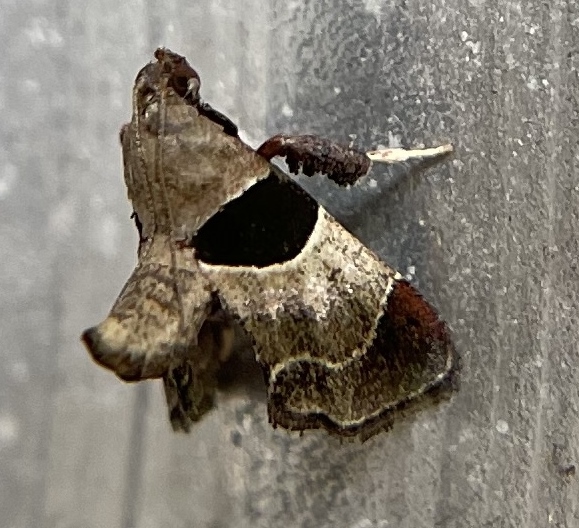National Moth Week 2021 is July 17-25 — this year it’s being celebrated in all 50 U.S. states and 80 countries.
Moths have fun, exotic, romantic and sometimes slug-ugly common names — if they’ve got them at all.
Every moth species has a scientific name in Latin (often mixed with Greek). Most micro-moths only have a scientific name, but all macro-moths have an English name as well, according to butterfly-conservation.org. The smaller moths, those with wingspans of under 20 mm, (.7874 inches) are considered microlepidoptera, or micro-moths.
With some common moth names it’s like a who’s who of stating the obvious — like the brown-shaded gray moth, thin-lined emerald, bold marked granite — or how about the Victorian lamplighter moth with its two forward-aiming lanterns? One of my favorite-named moths is the four-patched bird-dropping moth — obviously named because that group of bird-drop moths resemble bird droppings.





Granted, all the common names aren’t looks-obvious. For instance, there are the veneers, chloraspilates, tubeworm and cutworm moths, prominent, wave, verbia, owlet, dysodias and hundreds more, of course, that don’t promote a visual image of reference.
If names aren’t interesting enough, check out the design and wing patterns.
The Stealth Bomber design of the faint-spotted palthis is a moth small enough to fit on your thumbnail.

Like native plants whose names often reflect a characteristic of the plant, some moth names do as well, like the eggplant leafroller — a rolled leaf on an eggplant plant may be holding a pupating leafroller moth. The moth itself has an interesting design and Art Deco-ish patterns on its wings.

Some names — on the surface — don’t make any sense at all, like the pretty green oak-slug moth, Euclea incisa. The caterpillars have a flattened body which is oddly shaped and has suckers instead of legs and feet so it can travel on the underside of leaves; “it glides along slug-like on the leaves of a variety of plants.” The adult moth doesn’t eat, instead spends all its energy reproducing, according to insectidentification.org.

Another favorite moth name is moonseed moth — what kind of name is that, right? Actually, it so happens that the moonseed moth was named for its host plant: moonseed vine. Plants in the moonseed family, Menispermaceae, are larval hosts; in the Valley, native variable leaf snailseed vine, a plant in the moonseed family, feeds moonseed caterpillars. Yes, that tenacious, prolific annoying vine that drives most people to distraction is useful! The moth itself is small, perhaps an inch front to back, and looks like a most beautiful, golden tapestry. A similar-looking moth, to the untrained viewer, is the soybean looper moth, a golden-glowing moth that is as beautiful as it is destructive.


Nothing’s safe from this looper; the larvae can digest an amazing variety of plant species! I’m including the following ad verbum from https://entnemdept.ufl.edu/creatures/field/soybean_looper.htm to maintain original research information collected on the soybean looper:
“Recorded on 174 plants across 39 plant families, the greatest numbers of plants belong to the families Asteraceae, Solanaceae, Fabaceae, Lamiaceae, Brassicaceae, Poaceae, Amaranthaceae, Euphorbiaceae, and Malvaceae (Specht et al. 2015). They also have a wide range of wild host species, which includes Amaranthus sp., Oxalis sp., kudzu, lantana, groundcherry, and cocklebur, among others (Martin et al. 1976, Specht et al. 2015). Soybean is the preferred host, but it also feeds on other agronomic crops such as peanut, cotton, and corn. Documentation on vegetable crops include peas, crucifers, sweet potatoes, tomatoes, bell peppers, bush beans, cucumber, and watermelon (Canerday and Arant 1966, Martin et al. 1976, Specht et al. 2015). Floriculture crops include African daisy, begonia, carnation, chrysanthemum, geranium, lantana, and sunflower (Specht et al. 2015).” — Indeed, beautiful but destructive!
Moths are colorful, too. The spotted spragueia, a species of bird dropping moths visited the inside of my black light lamp fixture the other morning.

Even the monochromatic Southern beet webworm moth and Santa Ana tussock moths have intricate designs, as does the brown toned Dimorphic tosale moth; the black and white moths aren’t at all dull either, with dynamic markings like on the Gracile palpita moth and the zebra conchytodes.





I could go on — but I won’t — there are about 4,700 documented species of moths in Texas, and I’ve barely captured photos of a few hundred.
I hope I’ve whetted your interest for a new hobby or study of the nature that surrounds us here in the Rio Grande Valley.
I’ve put up a moth sheet in various stations around our property the last two years. A typical gathering of visitors to it includes not only moths but bugs, other insects, toads, frogs, spiders, cicadas, bees, grasshoppers and lizards. It’s given me a lot of insight as to what’s on our property, what the habitat attracts and the variety of food that might support other wildlife.
During these past two rainy weeks, the moth sheet and black lights have been set up in the shelter of our front porch and it’s still managed to attract a great variety of moths and bugs.

Stay up late during National Moth Week 2021 — July 17-25. Check with local park personnel for possible mothing events. Alternatively, it’s easy to attract moths in your own yard by setting up a moth sheet and black light. For ideas, type moth sheet setup in your search engine or visit www.nationalmothweek.org.
Identifications were made through www.iNaturalist.org or via the iNaturalist phone app — an awesome data base and network of naturalists, citizen scientists and biologists that allows nature biodiversity observations to be uploaded and quickly identified. If you’re not yet familiar with it, check it out at www.iNaturalist.org.
Stay tuned: Moths are important; not all destroy agricultural crops and consider a moth garden!


Leave a Reply